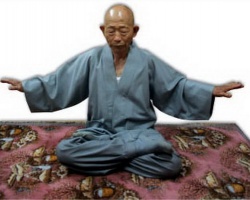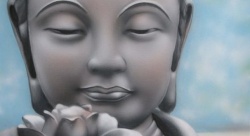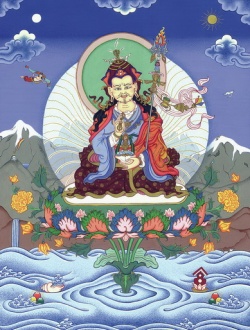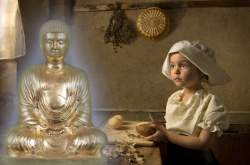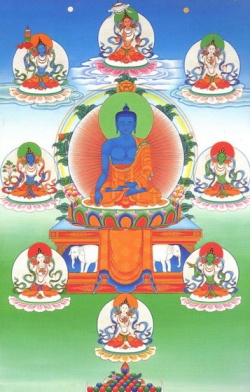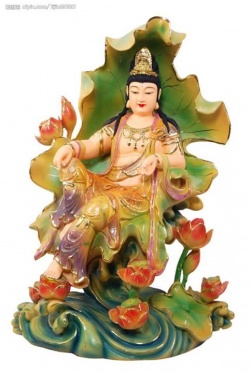Difference between revisions of "Tantrik Chakra"
(Created page with " <poem> Tantric history says that the word chakra is used to mean several different things in the Sanskrit sources: "Circle," used in a variety of senses...") |
m (Text replacement - "end" to "end") |
||
| (One intermediate revision by one other user not shown) | |||
| Line 1: | Line 1: | ||
| − | + | {{DisplayImages|1276|1284|3082|3908|834|4092}} | |
<poem> | <poem> | ||
[[Tantric]] history says that the [[word]] [[chakra]] is used to mean several different things in the [[Sanskrit]] sources: | [[Tantric]] history says that the [[word]] [[chakra]] is used to mean several different things in the [[Sanskrit]] sources: | ||
| Line 46: | Line 46: | ||
[[Chakras]] play an important role in the main surviving branch of [[Indian]] [[Vajrayana]], [[Tibetan Buddhism]]. They play a pivotal role in [[completion stage]] practices, where an attempt is made to bring the [[subtle winds]] of the [[body]] into the [[central channel]], to realise the [[clear light]] of [[bliss]] and [[emptiness]], and to attain [[Buddhahood]].[10] | [[Chakras]] play an important role in the main surviving branch of [[Indian]] [[Vajrayana]], [[Tibetan Buddhism]]. They play a pivotal role in [[completion stage]] practices, where an attempt is made to bring the [[subtle winds]] of the [[body]] into the [[central channel]], to realise the [[clear light]] of [[bliss]] and [[emptiness]], and to attain [[Buddhahood]].[10] | ||
| − | The [[Vajrayana]] system states that the [[central channel]] ([[avadhūtī]]) begins at the point of the [[third eye]], curves up to the {{Wiki|crown}} of the head, and then goes straight down to the lower [[body]]. There are two side channels, the [[rasanā]] and [[lalanā]], which start at their respective nostrils and then travel down to the lower [[body]]. The [[apāna vāyu]] governs the lower terminations of the three channels. The lower | + | The [[Vajrayana]] system states that the [[central channel]] ([[avadhūtī]]) begins at the point of the [[third eye]], curves up to the {{Wiki|crown}} of the head, and then goes straight down to the lower [[body]]. There are two side channels, the [[rasanā]] and [[lalanā]], which start at their respective nostrils and then travel down to the lower [[body]]. The [[apāna vāyu]] governs the lower terminations of the three channels. The lower end of the [[central channel]] ends in the {{Wiki|rectum}}. The lower end of the [[lalanā]] ends in the urinary tract. The lower end of the [[rasanā]] [[channel]] emits semen.[citation needed] |
The side channels run parallel to the [[center channel]], except at locations such as the {{Wiki|navel}}, [[heart]], {{Wiki|throat}} and {{Wiki|crown}} (i.e. [[chakras]]) where the two side channels twist around the [[central channel]]. At the {{Wiki|navel}}, {{Wiki|throat}} and {{Wiki|crown}}, there is a twofold [[knot]] [[caused]] by each side [[channel]] twisting once around the [[central channel]]. At the [[heart wheel]] there is a sixfold [[knot]], where each side [[channel]] twists around three times. An important part of [[completion stage]] practice involves loosening and undoing these knots.[citation needed] | The side channels run parallel to the [[center channel]], except at locations such as the {{Wiki|navel}}, [[heart]], {{Wiki|throat}} and {{Wiki|crown}} (i.e. [[chakras]]) where the two side channels twist around the [[central channel]]. At the {{Wiki|navel}}, {{Wiki|throat}} and {{Wiki|crown}}, there is a twofold [[knot]] [[caused]] by each side [[channel]] twisting once around the [[central channel]]. At the [[heart wheel]] there is a sixfold [[knot]], where each side [[channel]] twists around three times. An important part of [[completion stage]] practice involves loosening and undoing these knots.[citation needed] | ||
Latest revision as of 13:46, 30 December 2014
Tantric history says that the word chakra is used to mean several different things in the Sanskrit sources:
"Circle," used in a variety of senses, symbolizing endless rotation of shakti.
A circle of people. In rituals there are different cakra-sādhanā in which adherents assemble and perform rites. According to the Niruttaratantra, chakras in the sense of assemblies are of 5 types.
The term chakra also is used to denote yantras or mystic diagrams, variously known as trikoṇa-cakra, aṣṭakoṇa-cakra, etc. Different "nerve plexus within the body."
In Buddhist literature the Sanskrit term cakra (Pali cakka) is used in a different sense of "circle," referring to a Buddhist conception of the Cycle of Rebirth consisting of six states in which beings may be reborn.
The linguist Jorma Koivulehto wrote (2001) of the annual Finnish Kekri celebration having borrowed the word from early Indo-Aryan.Indo-European cognates include Greek kuklos, Lithuanian kaklas, Tocharian B kokale and English "wheel," as well as "circle."
Cognates of "chakra" still exist in modern Asian languages as well. In Malay, "cakera" means "disc," e.g. "cakerva padat" = "compact disc."
History
While breath channels (nāḍis) of yogic practices had already been discussed in the classical Upanishads, it was not until the eighth-century Buddhist Hevajra Tantra and Caryāgiti, that hierarchies of chakras were introduced.
Characteristics
Texts and teachings present different numbers of chakras. Also different physical structures are considered chakras. David Gordon White thus emphasizes:
"In fact, there is no "standard" system of the cakras. Every school, sometimes every teacher within each school, has had their own cakra system."
The following features are common:
They form part of the body, along with the breath channels, or nadis, and the winds (vayus).
They are located along the central channel (sushumna/avadhūtī).
Two side channels cross the center channel at the location of the chakras.
They possess a number of 'petals' or 'spokes'.
They are generally associated with a mantra seed-syllable, and often with a variety of colours and deities.
Use in religious traditions
Hindu Tantra
Main article: Kundalini
Thousand Petalled Crown Chakra, Two Petalled Brow Chakra, Sixteen Petalled Throat Chakra (Nepal, 17th Century)
David Gordon White traces the modern popularity of the "Hindu" seven chakra system to Arthur Avalon's The Serpent Power, which was Avalon's translation of a late work, the Satcakranirupana.[8] In actuality, there are several models and systems present in Hindu tantric literature, as White documents.[9] Kundalini is a feature of Hindu chakra systems.
Buddhist Tantra
Vajrayana
Main article: Vajrayana
Chakras play an important role in the main surviving branch of Indian Vajrayana, Tibetan Buddhism. They play a pivotal role in completion stage practices, where an attempt is made to bring the subtle winds of the body into the central channel, to realise the clear light of bliss and emptiness, and to attain Buddhahood.[10]
The Vajrayana system states that the central channel (avadhūtī) begins at the point of the third eye, curves up to the crown of the head, and then goes straight down to the lower body. There are two side channels, the rasanā and lalanā, which start at their respective nostrils and then travel down to the lower body. The apāna vāyu governs the lower terminations of the three channels. The lower end of the central channel ends in the rectum. The lower end of the lalanā ends in the urinary tract. The lower end of the rasanā channel emits semen.[citation needed]
The side channels run parallel to the center channel, except at locations such as the navel, heart, throat and crown (i.e. chakras) where the two side channels twist around the central channel. At the navel, throat and crown, there is a twofold knot caused by each side channel twisting once around the central channel. At the heart wheel there is a sixfold knot, where each side channel twists around three times. An important part of completion stage practice involves loosening and undoing these knots.[citation needed]
Within the chakras exist the 'subtle drops'. The white drop exists in the crown, the red drop exists in the navel, and at the heart exists the indestructible red and white drop, which leaves the body at the time of death. In addition, each chakra has a number of 'spokes' or 'petals', which branch off into thousands of subtle channels running to every part of the body, and each contains a Sanskrit syllable.[citation needed]
By focusing on a specific chakra (while often holding the breath) the subtle winds enter the central channel. The chakra at which they enter is important in order to realise specific practices. For example, focusing on the subnavel area is important for the practice of tummo, or inner fire. Meditating on the heart chakra is important for realizing clear light. Meditating on the throat chakra is important for lucid dreaming and the practices of dream yoga. And meditating on the crown chakra is important for consciousness projection, either to another world, or into another body.[citation needed]
A result of energetic imbalance among the chakras is an almost continuous feeling of dissatisfaction. When the heart chakra is agitated, people lose touch with feelings and sensations, and that breeds the sense of dissatisfaction. That leads to looking outside for fulfillment. When people live in their heads, feelings are secondary; they are interpretations of mental images that are fed back to the individual. When awareness is focused on memories of past experiences and mental verbalisations, the energy flow to the head chakra increases and the energy flow to the heart chakra lessens. Without nurturing feelings of the heart a subtle form of anxiety arises which results in the self reaching out for experience. When the throat chakra settles and energy is distributed evenly between the head and the heart chakras, one is able to truly contact one's senses and touch real feelings.[11]
Bön
Chakras, according to the Himalayan Bönpo tradition, influence the quality of experience, because movement of vayu cannot be separated from experience. Each of the six major chakras are linked to experiential qualities of one of the six realms of existence.[10]
A modern teacher, Tenzin Wangyal Rinpoche, uses a computer analogy: main chakras are like hard drives. Each hard drive has many files. One of the files is always open in each of the chakras, no matter how "closed" that particular chakra may be. What is displayed by the file shapes experience.
The tsa lung practices such as those embodied in Trul Khor lineages open channels so lung (Lung is a Tibetan term cognate with vayu) may move without obstruction. Yoga opens chakras and evokes positive qualities associated with a particular chakra. In the hard drive analogy, the screen is cleared and a file is called up that contains positive, supportive qualities. A seed syllable (Sanskrit bija) is used both as a password that evokes the positive quality and the armour that sustains the quality.[10]
Tantric practice is said to eventually transform all experience into bliss. The practice aims to liberate from negative conditioning and leads to control over perception and cognition.[10]
Tenzin Wangyal Rinpoche teaches a version of the Six Lokas sadhana which works with the chakra system.
Qigong, the Dantian
Qigong also relies on a similar model of the human body as an energy system, except that it involves the circulation of qi (ki, chi) energy.[12][13] The Qi energy, equivalent to the Hindu Prana, flows through the energy channels called meridians, equivalent to the nadis, but two other energies are also important: Jing, or primordial essence, and Shen, or spirit energy.
In the principle circuit of qi, called the Microcosmic orbit, energy rises up a main meridian along the spine, but also comes back down the front torso. Throughout its cycle it enters various dantians (elixir fields) which act as furnaces, where the types of energy in the body (jing, qi and shen) are progressively refined.[14] These dantians play a very similar role to that of chakras. The number of dantians varies depending on the system; the navel dantian is the most well-known (it is called the Hara in Japan), but there is usually a Dantian located at the heart and between the eyebrows.[15] The lower dantian at or below the navel transforms essence, or jing, into qi energy. The middle dantian in the middle of the chest transforms qi energy into shen, or spirit, and the higher dantian at the level of the forehead (or at the top of the head), transforms Shen into wuji, infinite space of void.[16]
Christianity, Hesychasm
A completely separate contemplative movement within the Eastern Orthodox church is Hesychasm, a form of Christian meditation. Comparisons have been made between the Hesychastic centres of prayer and the position of the chakras.[17] Particular emphasis is placed upon the heart area. However, there is no talk about these centres as having any sort of metaphysical existence. Far more than in any of the cases discussed above, the centres are simply places to focus the concentration during prayer.
